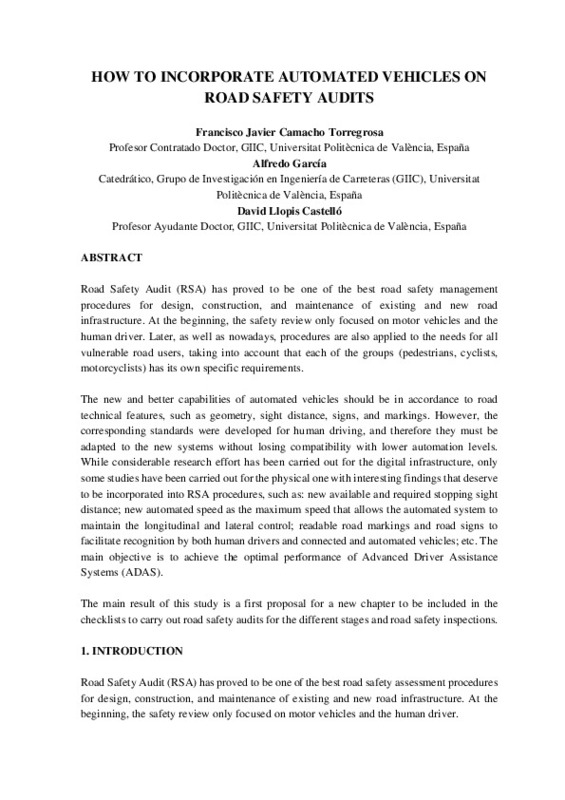JavaScript is disabled for your browser. Some features of this site may not work without it.
Buscar en RiuNet
Listar
Mi cuenta
Estadísticas
Ayuda RiuNet
Admin. UPV
How to incorporate automated vehicles on Road Safety Audits
Mostrar el registro sencillo del ítem
Ficheros en el ítem
| dc.contributor.author | Camacho-Torregrosa, Francisco Javier
|
es_ES |
| dc.contributor.author | García García, Alfredo
|
es_ES |
| dc.contributor.author | Llopis-Castelló, David
|
es_ES |
| dc.date.accessioned | 2023-01-17T07:26:27Z | |
| dc.date.available | 2023-01-17T07:26:27Z | |
| dc.date.issued | 2021-07-08 | es_ES |
| dc.identifier.isbn | 978-84-18465-12-3 | es_ES |
| dc.identifier.uri | http://hdl.handle.net/10251/191347 | |
| dc.description.abstract | [EN] Road Safety Audit (RSA) has proved to be one of the best road safety management procedures for design, construction, and maintenance of existing and new road infrastructure. At the beginning, the safety review only focused on motor vehicles and the human driver. Later, as well as nowadays, procedures are also applied to the needs for all vulnerable road users, taking into account that each of the groups (pedestrians, cyclists, motorcyclists) has its own specific requirements. The new and better capabilities of automated vehicles should be in accordance to road technical features, such as geometry, sight distance, signs, and markings. However, the corresponding standards were developed for human driving, and therefore they must be adapted to the new systems without losing compatibility with lower automation levels. While considerable research effort has been carried out for the digital infrastructure, only some studies have been carried out for the physical one with interesting findings that deserve to be incorporated into RSA procedures, such as: new available and required stopping sight distance; new automated speed as the maximum speed that allows the automated system to maintain the longitudinal and lateral control; readable road markings and road signs to facilitate recognition by both human drivers and connected and automated vehicles; etc. The main objective is to achieve the optimal performance of Advanced Driver Assistance Systems (ADAS). The main result of this study is a first proposal for a new chapter to be included in the checklists to carry out road safety audits for the different stages and road safety inspections. | es_ES |
| dc.language | Inglés | es_ES |
| dc.publisher | Universidad de Burgos | es_ES |
| dc.relation.ispartof | R-Evolucionando el transporte | es_ES |
| dc.rights | Reserva de todos los derechos | es_ES |
| dc.subject | Road safety | es_ES |
| dc.subject | Road safety audit | es_ES |
| dc.subject | Automated vehicle | es_ES |
| dc.subject | Road design | es_ES |
| dc.subject.classification | INGENIERIA E INFRAESTRUCTURA DE LOS TRANSPORTES | es_ES |
| dc.title | How to incorporate automated vehicles on Road Safety Audits | es_ES |
| dc.type | Comunicación en congreso | es_ES |
| dc.type | Capítulo de libro | es_ES |
| dc.rights.accessRights | Abierto | es_ES |
| dc.contributor.affiliation | Universitat Politècnica de València. Escuela Técnica Superior de Ingenieros de Caminos, Canales y Puertos - Escola Tècnica Superior d'Enginyers de Camins, Canals i Ports | es_ES |
| dc.description.bibliographicCitation | Camacho-Torregrosa, FJ.; García García, A.; Llopis-Castelló, D. (2021). How to incorporate automated vehicles on Road Safety Audits. Universidad de Burgos. 3113-3134. http://hdl.handle.net/10251/191347 | es_ES |
| dc.description.accrualMethod | S | es_ES |
| dc.relation.conferencename | XIV Congreso de Ingeniería del Transporte (CIT 2021) | es_ES |
| dc.relation.conferencedate | Julio 06-08,2021 | es_ES |
| dc.relation.conferenceplace | Online | es_ES |
| dc.relation.publisherversion | https://www3.ubu.es/cit2021/index.html | es_ES |
| dc.description.upvformatpinicio | 3113 | es_ES |
| dc.description.upvformatpfin | 3134 | es_ES |
| dc.type.version | info:eu-repo/semantics/publishedVersion | es_ES |
| dc.relation.pasarela | S\442027 | es_ES |






